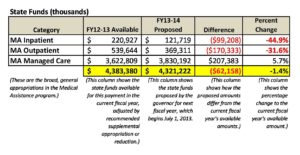The Major Medical Assistance Spending Categories
Last Tuesday, Pennsylvania Governor Tom Corbett unveiled his proposed state FY 2014 budget. Later that day, members of the Safety-Net Association of Pennsylvania (SNAP) received a comprehensive memo outlining the governor’s budget proposal with an emphasis on the issues that matter most to the state’s 61 private safety-net hospitals.
Over a seven-day period, SNAP presents in this space the highlights of the governor’s budget, again with an emphasis on Medical Assistance and other matters of special interest to Pennsylvania’s safety-net hospitals. Today, SNAP takes a look at what the proposed budget says about the major Medical Assistance spending categories.
The proposed budget calls for what on the surface appear to be sizeable decreases in state funds available for Medical Assistance inpatient and outpatient funding – a decrease of 44.9 percent in inpatient and 31.6 percent in outpatient funding. What this actually represents, however, is the state’s continued shift toward greater use of managed care through its expanded HealthChoices program, which has been budgeted for a 5.7 percent increase in funding. Overall, the combined changes in the inpatient, outpatient, and capitation lines of the proposed budget represent a 1.4 percent decrease in the amount of state money available for physical health services.

Click on the accompanying chart to see the proposed changes in the state’s funding allocations for the major categories of Medical Assistance physical health spending from FY 2013 to FY 2014.
Tomorrow: Hospital Assessment Revenue